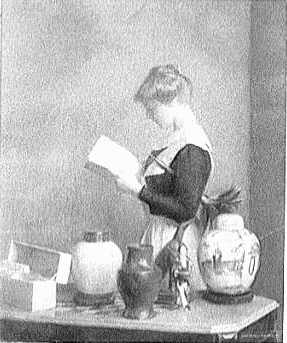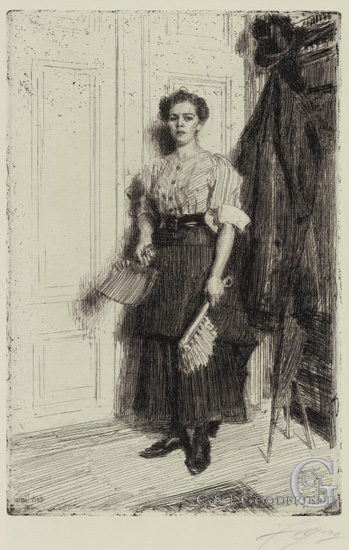
Household Workers
So, the factory work didn't appeal to you? Well, maybe working in the household of a middle-class family might be more up your alley. Are you ready to do anything they ask you to do? Get ready to cook and clean, girl. It is time to get dirt under your nails and sweat on your forehead. Come see what hard work is all about.

(maid circa 1900)
If you chose to work in another family's household as the girl pictured above, then you would have joined a number of women in Chicago who chose the same path from 1890-1930. The obligations of a household worker begins early in the morning and may extend past dinnertime, and it may include jobs such as cooking, cleaning, and taking care of children. Although the life of such an individual has both positive and negative aspects, B. Eleanor Johnson noted in a study of household workers in Chicago that “the social stigma attached to [household employment]” places it on a lower plane than other occupations (7).

It may be due to this stigma that Carrie does not consider household employment when she arrives to Chicago in Sister Carrie, but evidence that such jobs existed is seen in the home of Hurstwood. As Dreiser describes Hurstwood's home, he reveals that Hurstwood shares it with his wife, two children, and a “maid-servant, represented from time to time by girls of various extraction” (4). The characteristics of such employment are uncovered in Johnson's study, entitled Household Employment in Chicago , which was published in 1933. The researchers at this time asserted that “conditions that existed 40 years ago still exist” (7), which implies that the results from the study can be applied to the time span from around 1890 to 1930 in Chicago .
The study revealed that, as a household worker, you will be amongst women of all ages. Of the 552 individuals in this particular group, the majority are between the ages of 25 and 44. Almost 24% of them are around Carrie's age, however, and the remaining women are younger than 18 or older than 44 (7). The expectations of these workers vary from household to household, but the current study found certain trends. As a member of this group, you may be employed as a general worker, or possibly as a cook, second-girl, child's nurse, or chambermaid (7). As illustrated in the picture to the left, many of your duties will probably include household chores.
If you chose to be a general worker, then you will be expected to be an expert in everything domestic. The tasks expected of you may include the following:
• Care for plants • Care for children • Take children to school • Make children eat • Care for furnace • Care for fuel oil • Shovel walks • Clean up yard • Clean basement • Clean house • Wash walls and ceiling • Take down screens |
• Clean woolen garments in naptha • Mend and sew • Press dresses • Manicure nails and perform other personal services • Make appointments for employer • Carry luggage • Make candy • Serve at parties • Go on errands • Varnish furniture • Wash auto • Bathe and care for dogs and cats |
(7).
At this time, there was no set standard for hours or wages of household employees. In general, however, it is improbable that you will be needed in your home before 7 a.m. or after 8 p.m. You will probably find yourself in a home similar to those found in Johnson's study, with the average household needing its employees from 7 a.m. until 2 p.m., and from 5 p.m. to 8 p.m. during the week. You will probably be expected to work on Sundays from 8 a.m. to 2 p.m. Thus, as a household worker, you can expect to work ten-hour days during the week, and you will have to work for six hours on Sunday (7). You can also expect to earn about $19.50 as a Caucasian employee, or about $17 as an African American employee. Overall, the wages from this study range from under $10 to over $35. If you live with your employer, as did the majority of the employees in the study, this will cause a decrease in your weekly income due to room and board (7).
The description of household employment in Johnson's study reveals the extended work, long hours, and low pay of you and your fellow household workers. After reviewing the characteristics of such a job, Carrie's own attitude at the outset of the novel provides evidence for Dreiser's failure to include such an occupation as a possibility for her. When she is hired at Speigelheim & Co., Carrie “[cannot] believe that she [will] take the place," and she describes the factory as “grimy and low” (4). From Carrie's reaction to the factory, it is clear that she imagines a more luxurious life for herself. The factory work that she abandons, however, is considered superior to the household employment described in Johnson's study. As a result, Carrie never considers such work, and it is not mentioned until the reader is given a view of Hurstwood's home.
Although Carrie would probably not partake in such work, the characteristics of household work also have some good qualities. Johnson describes this employment as unlike any other. It varies in character, because the worker is not confined to one specific job. As a result, the actual work is diversified, and the worker possesses a “greater possibility for interest and exercising creative faculties” (7). This differs greatly from the monotony of work in a factory. Household employment also differs from factory employment in regards to the household employee's ability to determine when she completes specific tasks and how much time she spends on each task (7). Thus, though there is a social stigma attached to household employment, it possesses some positive qualities.
If you are not satisfied with your decision to become a household employer, then you may want to return to your home base in Chicago and explore other possibilities as a woman at this time. . .